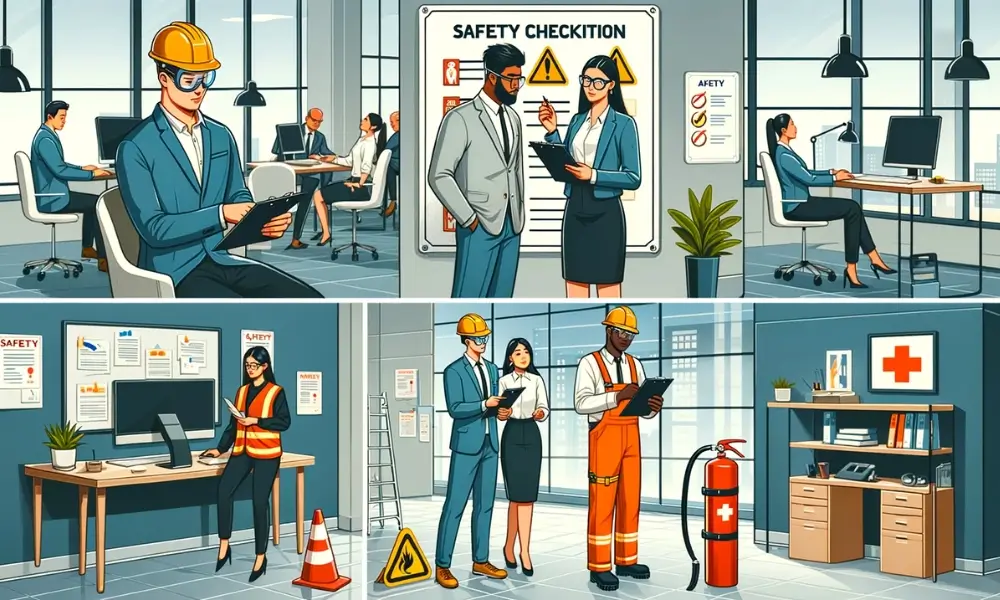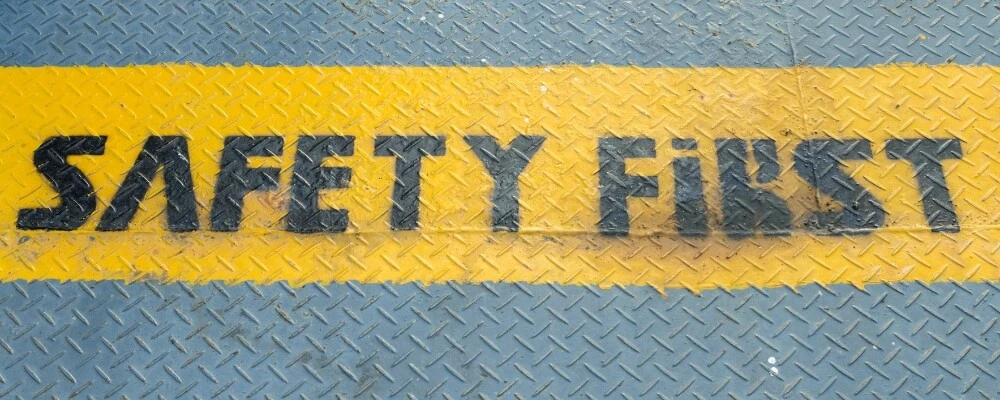How To Ensure Workplace Health and Safety Compliance

Workplace health and safety compliance is of utmost importance in any organization. It ensures the well-being of employees, reduces the risk of accidents, and contributes to a positive work environment. By adhering to health and safety regulations, companies can prevent costly legal battles, reputational damage, and employee dissatisfaction. However, implementing and maintaining compliance can be a complex task, especially in industries with high-risk environments.
In this article, I will provide essential tips and guidelines on how to ensure workplace health and safety compliance. By following these strategies, organizations can prioritize the safety and well-being of their employees while also staying in line with legal requirements.

What’s Health And Safety Compliance?
Health and Safety Compliance refers to the adherence to laws, regulations, guidelines, and specifications relevant to the workplace to ensure the well-being and protection of employees and other stakeholders. It involves creating a safe working environment, preventing accidents and work-related illnesses, and promoting the health and well-being of employees.
Importance Of Health And Safety Compliance
The importance of Health and Safety Compliance cannot be overstated, as it plays a crucial role in maintaining a safe and healthy working environment. Here are several reasons why it is vital:
- Employee Well-being: Compliance ensures the well-being and safety of employees, reducing the risk of accidents, injuries, and illnesses in the workplace.
- Legal Obligation: Organizations are legally obliged to comply with health and safety laws and regulations. Non-compliance can result in fines, lawsuits, and even imprisonment for severe violations.
- Financial Implications: Compliance helps in avoiding the financial costs associated with workplace accidents and illnesses, such as medical expenses, compensation claims, and increased insurance premiums.
- Productivity and Morale: A safe and healthy work environment boosts employee morale and productivity. Employees are more motivated and efficient when they feel valued and protected.
- Reputation Management: Compliance with health and safety standards enhances an organization’s reputation and brand image. It demonstrates a commitment to ethical practices and social responsibility.
- Business Continuity: By minimizing disruptions caused by accidents and illnesses, compliance helps ensure the continuity and sustainability of business operations.
- Corporate Social Responsibility: Compliance is a key component of corporate social responsibility. It reflects an organization’s commitment to the well-being of its employees and the community at large.
- Risk Management: Identifying and mitigating health and safety risks helps in preventing accidents and incidents, thereby managing operational risks effectively.
- Talent Attraction and Retention: A strong health and safety record can attract high-quality talent and reduce employee turnover, as people prefer to work for organizations that prioritize their well-being.
- Quality of Work: A safe environment and healthy employees contribute to the quality of work and services provided, leading to customer satisfaction and business growth.
- Social and Ethical Responsibility: Compliance demonstrates an organization’s commitment to ethical business practices and its responsibility towards employees and society.
- Enhanced Stakeholder Trust: Compliance builds trust among stakeholders, including employees, customers, suppliers, and investors, by showcasing the organization’s commitment to safety and ethical practices.

How To Ensure Workplace Health and Safety Compliance
Ensuring workplace health and safety compliance is a multifaceted process that requires a proactive and systematic approach. Here are ten essential steps to help your business maintain a safe work environment and meet regulatory standards.
1. Understand the Legal Requirements
Begin by familiarizing yourself with the legal requirements for health and safety in your jurisdiction. This includes federal regulations from OSHA as well as any state-specific laws. Understanding these requirements is the foundation of building a compliant safety program.
2. Develop a Health and Safety Policy
Create a comprehensive health and safety policy that outlines your commitment to safety, the responsibilities of management and employees, and the procedures for identifying and reporting hazards.
3. Conduct Regular Risk Assessments
Regularly assess your workplace for potential hazards related to equipment, processes, or the environment. This will help you identify areas where safety measures are needed to prevent accidents and injuries.
4. Provide Training and Resources
Ensure that all employees receive thorough training on health and safety practices relevant to their roles. Provide resources and continuous learning opportunities to keep them informed about safety procedures and updates.
5. Implement Safety Procedures and Protocols
Develop and implement clear safety procedures and protocols. These should include emergency response plans, equipment handling guidelines, and any other procedures necessary to mitigate risks.
6. Engage Employees in Safety Practices
Involve employees in safety practices by encouraging them to participate in safety meetings, report hazards, and contribute to the continuous improvement of safety procedures.
7. Invest in Appropriate Safety Equipment
Provide the necessary safety equipment, from personal protective equipment (PPE) to safety guards on machines. Ensure that all equipment is well-maintained and that employees know how to use it correctly.
8. Regularly Inspect and Maintain Equipment
Conduct regular inspections and maintenance of all workplace equipment to ensure it is in safe working order. This helps prevent accidents caused by equipment failure.
9. Monitor Compliance and Enforce Policies
Monitor your workplace to ensure that health and safety policies are being followed. Enforce these policies consistently, and take corrective action when necessary.
10. Review and Update Safety Measures
Regularly review and update your health and safety measures to adapt to any changes in the workplace, such as new equipment, processes, or regulations. Continuous improvement is key to maintaining compliance.
What Are the Roles of Employees in Safety Compliance?
Employees play a pivotal role in ensuring safety compliance within the workplace. Their responsibilities in this domain are multifaceted and include the following key aspects:
- Active Participation in Safety Training: Employees must actively participate in all safety training sessions provided by the employer. This is where they learn about potential workplace hazards, the correct use of safety equipment, and emergency procedures. Understanding the risks and knowing how to respond to them is crucial for maintaining a safe work environment.
- Understanding and Adherence to Safety Protocols: After training, employees are expected to understand and adhere to the safety protocols established by their employer. This includes following procedures for operating machinery safely, using personal protective equipment (PPE) when required, and adhering to safety signage and warnings.
- Vigilance and Hazard Identification: One of the most proactive roles of employees is to remain vigilant for potential hazards. This could involve identifying risks such as spills that could cause slips, noticing malfunctioning equipment, or recognizing unsafe behaviours in colleagues. Early identification of hazards is critical to preventing accidents.
- Reporting Hazards and Incidents: When employees identify a hazard, they are responsible for reporting it to the appropriate supervisor or safety officer. Timely reporting can lead to quick action, reducing the risk of harm. Similarly, if an incident occurs, employees should report it immediately so that proper procedures can be followed and recurrence can be prevented.
- Contributing to Safety Meetings and Inspections: Employees should be encouraged to contribute to safety meetings and participate in safety inspections. Their input is valuable because they are often the most familiar with the day-to-day operations and potential risks in their specific work areas.
- Maintaining a Safe Work Area: Employees are responsible for keeping their work area clean and organized to prevent accidents. This includes proper storage of materials, disposing of waste appropriately, and ensuring that walkways are clear.
- Peer Support and Communication: Supporting and reminding colleagues about safety practices is another way employees contribute to a safe work environment. This peer-to-peer communication reinforces the importance of safety and helps maintain collective awareness.
- Emergency Response: In the event of an emergency, employees must know their role, whether it’s evacuating, assisting with first aid, or executing specific tasks designated in the emergency plan. Their response can save lives and minimize damage.
- Continuous Learning: Safety compliance is an ongoing process, and employees should be open to learning and adapting as new safety standards or procedures are introduced. Continuous learning also involves staying updated on changes to safety regulations that affect their job.
- Personal Responsibility: Ultimately, each employee has a personal responsibility for their own safety and the safety of their colleagues. This means taking the initiative to act safely, even when not being directly supervised.
By fulfilling these roles, employees not only protect themselves and their colleagues but also contribute to the overall safety culture of the organization. This collective effort is essential for achieving and maintaining high standards of workplace health and safety compliance.

Understanding OSHA Regulations and Their Impact on Your Business
The Occupational Safety and Health Administration (OSHA) is a regulatory agency of the United States Department of Labor that has the authority to enforce safety and health legislation. Here’s a closer look at how understanding OSHA regulations is crucial for businesses:
OSHA’s mission is to ensure safe and healthful working conditions by setting and enforcing standards and by providing training, outreach, education, and assistance. The regulations cover a wide range of workplace safety issues, from specific equipment use to general work environment standards.
Impact on Businesses
For businesses, compliance with OSHA regulations is legally mandatory. The impact of these regulations is significant in several ways:
- Safety Culture: OSHA standards help in creating a framework for a safety culture within the organization. By following these guidelines, businesses can significantly reduce the number of workplace accidents and illnesses.
- Legal and Financial Consequences: Non-compliance can lead to legal actions, including fines and penalties. These can be substantial and may also lead to increased insurance premiums or even criminal charges in cases of gross negligence.
- Employee Trust and Morale: A safe work environment fosters trust and boosts the morale of employees. They are more likely to be productive and engaged when they know their employer is committed to their safety.
- Reputation: Compliance affects a company’s reputation among customers, partners, and potential employees. A good safety record can be a competitive advantage, while non-compliance can damage a company’s public image and brand.
- Operational Continuity: Compliance with safety regulations helps ensure that businesses can operate without interruptions caused by workplace accidents or related investigations and legal proceedings.
Steps to Compliance
Understanding and complying with OSHA regulations involves several steps:
- Assessment: Regularly assess your workplace for compliance with OSHA standards. This includes understanding which specific regulations apply to your industry and operations.
- Training: Provide comprehensive training for employees on relevant OSHA regulations and ensure they understand how to comply with them.
- Implementation: Develop and implement workplace safety protocols in line with OSHA standards. This includes everything from proper signage and equipment maintenance to emergency procedures.
- Documentation: Keep detailed records of your compliance efforts, including training, incident reports, and safety meetings. OSHA may require access to these records during inspections.
- Stay Updated: OSHA regulations can change, and it’s essential to stay informed about any updates or new regulations that may affect your business.
Seeking Assistance
Understanding and implementing OSHA regulations can be complex, especially for small businesses without dedicated safety officers. OSHA offers a variety of resources to assist businesses in compliance, including consultation services, training programs, and a wealth of online resources.
In summary, understanding OSHA regulations is not just about legal compliance; it’s about integrating safety into the fabric of your business operations. It’s a continuous process that protects employees, preserves business integrity, and enhances operational efficiency.
The Financial and Ethical Implications of Non-Compliance
Non-compliance with workplace health and safety standards can have serious financial and ethical implications for a business. Here’s a breakdown of these consequences:
Financial Implications
- Fines and Penalties: Regulatory bodies like OSHA have the authority to levy fines on businesses that fail to comply with safety regulations. These fines can be substantial, especially in cases of serious breaches or repeated violations.
- Compensation Claims: If an employee is injured due to non-compliance with safety standards, they may be entitled to compensation. The costs associated with workers’ compensation claims or legal settlements can be significant.
- Increased Insurance Premiums: A poor safety record can lead to higher insurance premiums as insurers assess the increased risk of future claims. This is an additional ongoing cost that can affect a business’s bottom line.
- Operational Disruptions:Accidents or incidents can lead to operational disruptions, such as downtime during investigations or the loss of skilled employees due to injury. This can result in lost productivity and revenue.
- Remediation Costs: A business may need to spend money to address the causes of non-compliance, which might include upgrading equipment, modifying facilities, or additional training for employees.
Ethical Implications
- Employee Wellbeing: There is an inherent ethical responsibility for employers to ensure the safety and well-being of their employees. Non-compliance can put employees at risk of harm, which is a breach of this moral duty.
- Public Perception: A company’s reputation can be severely damaged by incidents arising from non-compliance, leading to a loss of public trust. This can have long-term effects on customer loyalty and brand value.
- Employee Morale and Retention: Employees are less likely to feel valued and safe in a non-compliant environment, which can lead to low morale and high turnover. The cost of recruiting and training new employees to replace those who leave can be substantial.
- Legal and Moral Accountability: Business owners and managers may face personal legal accountability for egregious cases of non-compliance. Beyond legal repercussions, there is also the moral weight of responsibility for any harm that comes to employees.
- Industry Standing: Non-compliance can affect a company’s standing within its industry. It can lead to a loss of business partnerships, as other companies may not want to associate with a business that has a poor safety record.
Balancing Financial and Ethical Considerations
Business owners must balance financial considerations with ethical obligations. While implementing comprehensive safety measures may incur costs, the financial implications of non-compliance can be far more severe. Ethically, the cost of compromising on safety can be immeasurable if it results in injury or loss of life.
The Role of Regular Safety Audits in Maintaining Compliance
Regular safety audits are an indispensable part of a comprehensive safety compliance strategy. They serve several key functions in maintaining a safe workplace:
- Identification of Hazards: Safety audits involve a systematic review of all workplace operations, equipment, and facilities to identify potential safety hazards. This proactive approach allows businesses to spot issues that may not be immediately obvious during day-to-day operations. By catching these hazards early, companies can take corrective action before accidents occur.
- Verification of Compliance: Audits are used to verify that the company’s safety practices are in line with legal requirements and industry standards. They ensure that all aspects of the company’s operations are compliant with OSHA regulations and any other applicable safety standards. This verification process is crucial to avoid the legal repercussions of non-compliance.
- Evaluation of Safety Procedures: During an audit, existing safety procedures are evaluated for their effectiveness. This includes reviewing emergency response procedures, equipment handling protocols, and employee safety training programs. Auditors look for gaps in these procedures and recommend enhancements to ensure they are as effective as possible.
- Reinforcement of Safety Culture: Regular audits reinforce a culture of safety within the organization. They send a clear message to employees that the company takes their health and safety seriously. This can improve employee morale and encourage everyone to be more vigilant about safety in their daily tasks.
- Engagement with Employees: Safety audits often involve discussions with employees to get their perspective on safety issues. This engagement can uncover concerns that may not be apparent through a simple inspection. It also helps employees feel involved in the process, which can increase their commitment to safety practices.
- Documentation and Record-Keeping: Audits provide documentation of a company’s safety efforts. This can be invaluable in the event of a workplace incident or an OSHA inspection. Records of regular audits demonstrate a company’s ongoing commitment to safety compliance.
- Continuous Improvement: Safety audits are not just about maintaining the status quo; they’re about continuous improvement. By regularly identifying areas for improvement and implementing changes, companies can make their workplaces safer over time. This process of continual refinement is at the heart of a robust safety compliance program.
- Benchmarking: Regular audits allow companies to benchmark their safety practices against those of other businesses in their industry. This can be a powerful motivator for improvement and can help businesses stay competitive.
- Risk Management: Ultimately, safety audits are a form of risk management. They help businesses manage the risks associated with workplace accidents and occupational illnesses. By systematically reducing these risks, companies can protect their employees and their bottom lines.
Regular safety audits are a vital tool for any business that is serious about safety compliance. They provide a structured approach to identifying and mitigating risks, ensuring compliance with regulations, and fostering a culture of safety within the organization.
Investing in Safety Training: A Necessity or an Option?
Investing in safety training is unquestionably a necessity for several compelling reasons:
- Legal Obligation: Many jurisdictions legally require certain safety training for employees, especially in industries that are considered high-risk.
- Accident Prevention: Proper training can significantly reduce the number of workplace accidents by ensuring that employees know how to work safely and use the equipment correctly.
- Cost Savings: While there is an upfront cost to safety training, it can lead to long-term savings by reducing accidents, which in turn can lower insurance premiums and reduce the costs associated with workplace injuries.
- Employee Confidence: When employees are trained and knowledgeable about safety practices, they feel more confident in their roles, which can improve overall productivity and job satisfaction.
- Reputation Management: Companies known for their commitment to safety are more attractive to potential employees and may be preferred by customers and partners.
The Importance of a Safety Management System in Compliance
A safety management system (SMS) is crucial for several reasons:
- Structured Approach: An SMS provides a structured and documented approach to managing safety, including the development of policies, the assignment of responsibilities, and the procedures for risk assessments and incident reporting.
- Compliance Tracking: It helps in tracking compliance with internal policies and external regulations, making it easier to identify areas where the organization may be falling short.
- Continuous Improvement: An effective SMS is not static; it allows for continuous monitoring and improvement of safety practices.
- Accountability: It clearly defines roles and responsibilities, which is essential for accountability and ensures that everyone knows their part in maintaining safety.
How to Handle Safety Compliance in the Face of New Hazards?
Handling safety compliance in the face of new hazards involves:
- Regular Risk Assessments: Conducting these assessments to identify new hazards as they emerge.
- Agility: Being able to adapt safety protocols and training to address new risks quickly.
- Investment in Technology: Using new technologies that can help identify risks or provide better protection against them.
- Employee Feedback: Encouraging feedback from employees who may be the first to recognize new hazards.
Building a Culture of Safety: Beyond Compliance
Building a culture of safety goes beyond mere compliance:
- Leadership Commitment: It starts at the top with leaders who prioritize safety and are willing to invest time and resources into safety initiatives.
- Employee Involvement: Employees should be encouraged to participate in safety discussions, contribute to safety decisions, and report unsafe conditions or behaviours.
- Recognition and Rewards: Recognizing and rewarding safe behaviours can reinforce the importance of safety and encourage continued compliance.
- Communication: Open lines of communication about safety issues help to foster an environment where safety is considered a shared responsibility.
- Integration into Daily Operations: Safety should be integrated into daily operations rather than being seen as a separate or external process.
What is workplace health and safety compliance?
Workplace health and safety compliance refers to the adherence and conformance to the regulations, standards, and guidelines set by occupational health and safety authorities to ensure the safety and well-being of employees.
Why is it important to ensure workplace health and safety compliance?
Ensuring workplace health and safety compliance is of utmost importance as it helps protect employees from occupational hazards, minimizes the risk of accidents and injuries, and fosters a healthy work environment.
How can organizations ensure safety compliance?
Organizations can ensure safety compliance by implementing robust safety programs, conducting regular safety compliance audits, providing appropriate training to employees, and creating a culture of commitment to safety at all levels of the organization.
What is EHS compliance?
EHS compliance stands for Environment, Health, and Safety compliance. It refers to the adherence to environmental, health, and safety regulations and standards to protect employees, the community, and the environment from potential hazards and risks.
How does safety compliance management help companies?
Safety compliance management enables companies to identify potential risks and implement policies and procedures to mitigate those risks. It helps in creating a safe work environment, reducing accidents and injuries, and avoiding fines and penalties associated with non-compliance.
What is a safety compliance audit?
A safety compliance audit is a systematic evaluation of an organization’s compliance with safety regulations and standards. It involves a comprehensive review of safety procedures, documentation, training records, and workplace conditions to ensure that they align with the required standards.
Why is a safety compliance audit important?
A safety compliance audit is important as it helps organizations identify any gaps or deficiencies in their safety programs and practices. It provides insights into areas that require improvement and ensures that the organization is meeting its legal obligations regarding workplace safety.
How can organizations incorporate safety compliance into their daily operations?
Organizations can incorporate safety compliance into their daily operations by developing a comprehensive safety compliance system, creating and implementing a safety checklist, conducting regular safety inspections, and encouraging active involvement and supervision of employees.
What are the consequences of non-compliance with safety standards?
Non-compliance with safety standards can have serious consequences for organizations. It can lead to accidents, injuries, fines, legal penalties, damage to the company’s reputation, and the loss of trust from employees and stakeholders.
How can organizations ensure successful compliance with safety standards?
Organizations can ensure successful compliance with safety standards by establishing clear objectives, providing adequate resources for safety measures, fostering a culture of safety among employees, and regularly monitoring and evaluating the effectiveness of safety programs.





